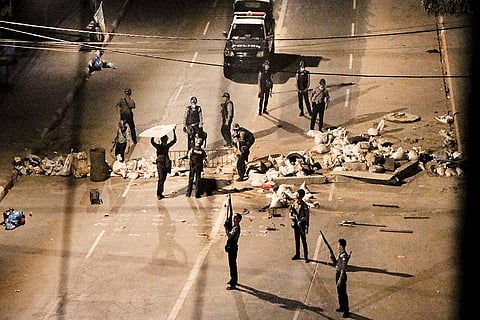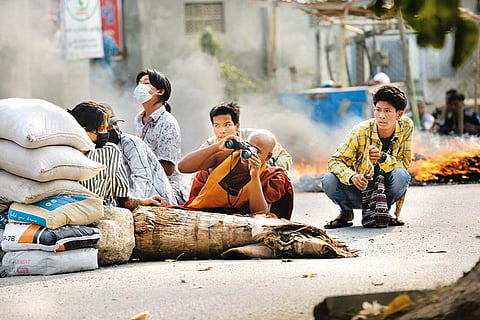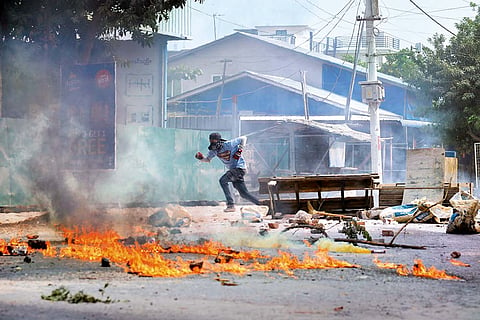The military coup in Myanmar—where daily acts of bold, spirited defiance are met with live bullets and bloodshed—has thrown up an unexpected challenge to the world’s largest democracy. How does India handle this brazen murder of democracy in its neighbourhood? What does it do with the Myanmarese fleeing military repression and seeking refuge in India? These questions have gained especial significance now, when the Quad, comprising the democracies of India, US, Japan and Australia, hopes to counter China’s one-party rule with liberal values and a rule-based, open Indo-Pacific. Balancing this with India’s strategic interests vis-a-vis a neighbouring country along its sensitive Northeast is a dilemma facing the Narendra Modi government.
Steady On Up The Irrawaddy
India is a liberal democracy and Quad member, and a friend too of the junta in Myanmar. The brutal coup catches New Delhi in a bind.
“The Indian government is at a loss on how to navigate a response to Myanmar. They are hoping the problem will go away,” says human rights activist Suhas Chakma. “As a member of the Quad, which stands for an open, liberal society, India has the added responsibility of taking a stand against Myanmar’s military.”
The early morning coup on February 1 was a response to what the army alleged was “large-scale election fraud” during the November 2020 national polls. Truly, the military was in no mood to accept the clean sweep by Aung San Suu Kyi’s National League for Democracy (NLD), even though it is well ensconced and its interests taken care of in the democratic set-up of Myanmar—one-third of parliamentary seats are reserved for it. Suu Kyi won 396 of the 498 seats—a bigger landslide than in the path-breaking 2015 polls. The coup was to prevent the winners from taking the oath of office that day, when the newly elected parliament was to meet. Instead, army commander Min Aung Hlaing arrested President U Win Myint, Suu Kyi, members of the country’s election commission and hundreds of top NLD leaders. The army declared a state of emergency for one year and threw hundreds of NLD activists into prison.

Armed police remove road blocks set up by protesters in Yangon.
But the people of Myanmar are no longer willing to give up without a fight. The civil disobedience movement called by pro-democracy activists has resulted in protests across all major towns. Neither the fear of death nor imprisonment has deterred the people. On March 3, the bloodiest day of the protests, 38 persons were gunned down. Every single day, reports pour in of defiance in the face of certain death.
More importantly, the pro-democracy agitation is supported by most of Myanmar’s ethnic groups—adversaries of the army and the majority Buddhist community for long. The civilian government had tried to work out a ceasefire with many of them, though so far nothing had materialised. That the ethnic tribes—each zealously guarding its own identity—are with the protestors is a hopeful sign. Religious leaders, too, have backed the protestors. Whether this unity is for real is not known.
While the US, EU and Western democracies have condemned the military take-over and directed sanctions against the army, Myanmar’s neighbours have been less vocal. India, China as well as the 10-member ASEAN group—of which Myanmar is a member—do not support sanctions.
Yet, at a time when both India and China competes for influence in Myanmar, neither country wants to antagonise the generals. In the past too, China had steadfastly stood by the military junta and will continue to do so. “The Chinese know that bilateral deals with military regimes works very well for them,” says JNU professor Mahendra Lama. He recalls that in 2019, at the second Chinese Belt and Road Forum, as MOUs were signed on the China-Myanmar Economic Corridor (CMEC), Aung San Suu Kyi welcomed the initiative, but stated that each project would be gauged to suit Myanmar. China was more at ease doing business with military regimes, says Lama, than with civilian governments that raise questions. Knowing that the military rely heavily on China, anti-China sentiments have come to the fore in the struggle for democracy. Chinese factories and businesses were attacked and set ablaze across Myanmar.
In the past, India had steadfastly opposed the military junta and sheltered pro-democracy activists fleeing repression. Till Rajiv Gandhi’s premiership, India refused to deal with Myanmar’s military. It has a backstory—after the 1960 military coup, when General Ne Win grabbed power, he drove out over 3,00,000 Indians who had settled in Myanmar for generations. But as China made deep inroads there, PM Narasimha Rao opted for realpolitik—deciding to begin engaging with the junta to checkmate China’s influence. Of course, grappling with Northeast insurgent groups, many of whom had camps in Myanmar, was another imperative. Though much of these forested areas were not controlled by Myanmar’s army, it was important to get its cooperation, and the Indian army had launched operations inside Myanmar with the permission of its military. Today, Northeast rebel groups are no longer a serious threat. New Delhi has several infrastructure projects in Myanmar like the trilateral highway and the Kaladan multi-modal project, as it strives to connect India’s Northeast to the ASEAN region.

A monk surveys the battle front.
Public opinion in the Indian states adjoining Myanmar favour its courageous people. Mizoram’s chief minister Zoramthanga has not waited for New Delhi’s signal—Mizos have ethnic and cultural relations with Myanmar’s Chin people and, belonging to the larger Zo ethnic group, consider themselves as one family. As several groups of Myanmarese, including policemen unwilling to fire on unarmed demonstrators, entered Mizoram, they were welcomed by state authorities. Myanmar authorities want all policemen who fled to India to be handed back.
While the home ministry has ordered closure of the international border with Myanmar, it had little impact. Zoramthanga has taken the lead in making sure the Chins are being sheltered and fed. There have been demonstrations in Aizawl and other towns against the military coup in Myanmar.

A protester jumps across a burning barricade.
Mizoram has urged New Delhi not to send back the refugees on humanitarian grounds. K.Vanlalvana, Rajya Sabha member of the ruling Mizo National Front, said in the Upper House: “Sending them (refugees) back would mean killing them”, pointing to India’s duty as a democratic nation to uphold these values.
“India is working quietly for a regional approach,” says author and commentator Sanjay Hazarika, who specialises on the Northeast. “Chief minister Zoramthanga has laid down the issues before Mizoram very clearly. It may not be the perspective of New Delhi, but they have to be respected, because they are based on ground realities and from someone who knows Myanmar well. He has even spoken to the Myanmar foreign minister in the last few days. So his location may give Zoramthanga a special advantage in reaching out to both sides of the Myanmar imbroglio. Policy-makers in Delhi may consider this approach,” says Hazarika.
India needs to continue its engagement with the military and work behind the scenes for the restoration of democracy. During the NDA period, when the Vajpayee government was working with the military junta, Burmese activists were bringing out a newspaper from the official residence of then defence minister George Fernandes. A similar, cautious approach may lead to satisfactory results.